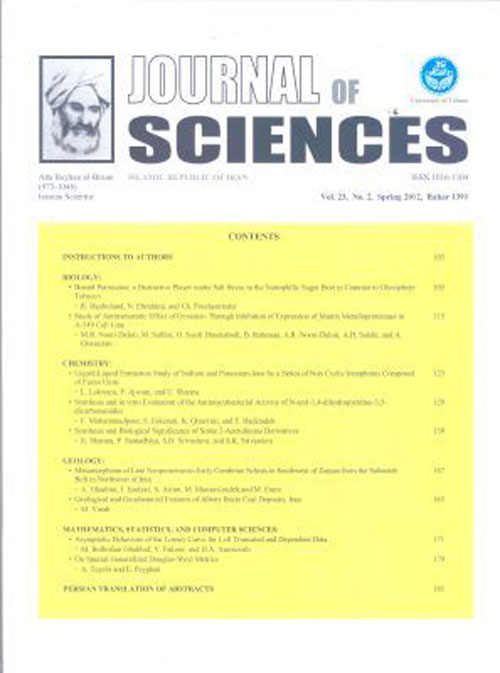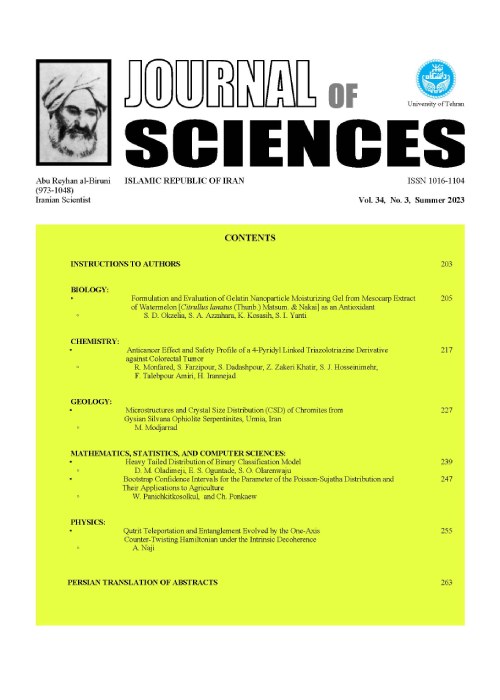فهرست مطالب

Journal of Sciences, Islamic Republic of Iran
Volume:28 Issue: 4, Autumn2017
- تاریخ انتشار: 1396/08/08
- تعداد عناوین: 6
-
-
Pages 305-312Achillea eriophora D.C. (Asteraceae), an endemic species in Iran, is used extensively in Iranian folk medicine to treat various ailments, including gastrointestinal disorders, skin inflammations and wound healing. The present study was aimed to investigate the effects of the methanolic extract of A. eriophora leaves on the stimulation of human fibroblast cell proliferation and migration as two pivotal stages in wound healing process. Methanolic extract was prepared by maceration method. Total phenol and flavonoid contents were measured using spectrophotometry. Cytotoxic and proliferation effects of the extract were evaluated by MTT assay on human fibroblast cells. Moreover, migration of the treated cells was assessed by the closure of a denuded area, made by scratching on the confluent monolayer cultures. The results of cytotoxicity assay indicated that the methanolic extract did not have any cytotoxic effect on fibroblast cells when used at concentrations up to 2 µg/mL. Human fibroblast proliferation was stimulated by low concentrations of the extract (0.1-0.8 µg/mL), and the highest level of proliferation was observed in the lowest treatment (0.1 µg/mL). Migration of the cells was induced by intermediate concentrations (1-30 µg/mL) of the extract and the most effective dose was estimated at 1 µg/mL. Due to the fact that lower concentration of the extract, which showed the best proliferation and migration stimulatory effects, were not toxic on the human fibroblast cells, the crude methanolic extract from the leaves of Achillea eriophora could be recommended as a potential source for improving the wound healing activity in skin.Keywords: Achillea eriophora, Wound healing, Fibroblast cells, proliferation, Migration
-
Pages 313-323A novel method for the preparation of α-zirconium phosphate (ZrP) nanoparticles as an eco-friendly and recyclable heterogeneous catalyst was studied. Polyethylene glycol (PEG) was used as the organic matrix which produced a better dispersion of ZrP nanoparticles. The catalyst was characterized by several physico-chemical techniques such as ICP-OES, XRD, TPD-NH3, pyridine-FTIR, BET, FTIR, TGA, SEM and TEM. The acidic property of ZrP was studied in the protection of aldehydes with acetic anhydride (AA) in the at room temperature. The deprotection of 1,1-diacetates has also been achieved using this catalyst in water. The procedure is operationally simple, environmentally benign and only a stoichiometric amount of AA is used. The catalyst was recovered easily from the reaction mixture, regenerated, and reused at least eight times without significant loss in catalytic activity.Keywords: Hexagonal zirconium phosphate, Nanoparticles, Solvent-free, Solid acid catalyst, Diacetate
-
Pages 325-336The aim of this study is to bridge a gap in the existence of Trilobites in the marine Permian successions of Iran by exploring a stratigraphic section of the Permian in Jamal Formation (Dizlu section). Based on comprehensive field studies and laboratory investigations three Trilobite specimens were identified in the study area including Pseudophillipsia (Carniphillipsia) dizluensis sp. nov., Pseudophillipsia (Carniphillipsia) sagittalis and Pseudophillipsia (Carniphillipsia) sp.. A new occurrence of trilobites collected from the Permian (Wordian) Jamal Formation at a section at Dizlu, Isfahan Province, Iran, is documented. They belong to a new species of Pseudophillipsia (Carniphillipsia), which is described herein, and can be attributed to the a group of species centered on P.(C). paffenholzi (Weber). It is based on 30 specimens from a single horizon, most of which are enrolled. Co-occurrence of Pseudophillipsia (Carniphillipsia) sp. A. and stenohalin groups such as brachiopods, bryozoans, and crinoids are indicating that this species were preferred shallow and carbonate environments. This is the first time that the existences of these specimens are reported in Dizlu section.Keywords: Trilobite, Pseudophillipsia (Carniphillipsia), biostratigraphy, Permian, Iran
-
Pages 337-347Brachiopod faunas from the Aptian- Cenomanian Vezk section in southwesternIran comprise ten species in six genera, namely Sellithyris cenomanensis, Sellithyris tornacensis, Sellithyris phaseolina, Phaseolina phaseolina, Tropeothyris sp., Concinnithyris subundata, Kingena arenosa, Cyclothyris difformis, Cyclothyris sp. and Cyclothyris compressa. All species are recorded for the first time from the lower Cretaceous of Vezk section (South of Yasuj). These deposits are composed of an alternation of green marls and thin layers of yellow shaly or sandy limestone, which overlain by thick bedded black limestone. The thickness of these deposits are 74 meters, which covers the Jurassic sediments, while its upper boundary ends with erosion surface that covered by Neogene deposits. These deposits consist of different fossil groups such as brachiopods, echinoids, corals, gastropods and orbitolinids that confirm the Aptian- Cenomanian ages for these sediments. The fauna assemblages suggest at shallow and suitable environment prevailed during the deposition of the strata.Keywords: Brachiopods, Aptian, Cenomanian, Yasuj, Iran
-
Pages 349-358Robat-e Zengejeh rocks affected by a variety of events began from Precambrian. This research studied preserved effects of the events. Regional metamorphism is the oldest event in this rocks include schist, amphibolite and orthogneiss, that reached up to amphibolite facies. After this regional metamorphism, it seems that mesocratic (624±5Ma) and hololeucocratic granitoides intruded respectively. Mesocratic and hololeucocratic granitoides deformed to granite-gneiss and gneiss along the northern main fault. Moreover, amphibolites show strong lineation along the faults, which as well as petrographic evidences point to the effects of dynamometamorphism in the area. Meatmorphism followed by low-grade regional metamorphism (low-greenschist facies) affected by granitoids of Robat-e Zengejeh. low-grade regional metamorphism, acted as a retrograde metamorphism for the paragenesis of the previous regional metamorphism. Finally, a sodic metasomatism affected Robat-e Zengejeh rocks which its mineralogical and geochemical evidences are significant.Keywords: Robat-e Zengejeh granitoides, Regional metamorphism, Dynamometamorphism, Sodic metasomatism
-
Pages 359-367Compact finite difference scheme is applied for a partial integro-differential equation with a weakly singular kernel. The product trapezoidal method is applied for discretization of the integral term. The order of accuracy in space and time is , where . Stability and convergence in norm are discussed through energy method. Numerical examples are provided to confirm the theoretical prediction and to show that the combination of the compact finite difference approximation and product trapezoidal method give an efficient method for solving a partial integro-differential equation.Keywords: Compact finite difference, Partial integro-differential equation, Product trapezoidal method, Stability, Convergence


